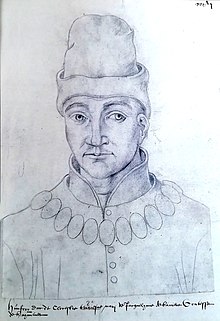Pemerintah Perwalian Inggris 1422–37
Pemerintahan Perwalian Inggris


Adipati Gloucester (atas) dan Henry Beaufort (bawah)
Pemerintahan perwalian Kerajaan Inggris dari 1422 sampai 1437 memerintah saat Henry VI masih terlalu kecil. Keputusan dibuat atas nama raja oleh Dewan Perwalian, yang terdiri dari orang-orang paling penting dan berpengaruh dalam pemerintahan Inggris, dan didominasi oleh paman raja Humphrey, Adipati Gloucester (saudara ayah dan pendahulu raja, Henry V) dan Uskup (Kardinal dari 1426) Henry Beaufort (paman tiri Gloucester).
Orang-orang yang masuk Dewan Perwalian pada 9 Desember 1422 adalah (Griffiths 1981, hlm. 23):
- John, Adipati Bedford
- Humphrey, Adipati Gloucester
- Thomas Beaufort, Adipati Exeter
- Henry Beaufort, Uskup Winchester
- Henry Chichele, Uskup Agung Canterbury
- John Kemp, Uskup London
- Philip Morgan, Uskup Worcester
- John Wakering,Uskup Norwich
- Ralph Neville, 1st Earl of Westmorland
- Henry Percy, 2nd Earl of Northumberland
- John Mowbray, 2nd Duke of Norfolk
- Edmund Mortimer, 5th Earl of March
- Richard Beauchamp, 13th Earl of Warwick
- Henry FitzHugh, 3rd Baron FitzHugh
- Sir John Tiptoft
- Ralph Cromwell, 3rd Baron Cromwell
- Sir Walter Hungerford
- Sir Walter Beauchamp
Referensi
- Beck, Sanderson (2010). "England under the Regency 1422–37". England of Henry IV, V, and VI 1399–1461.
- Griffiths, R. A. (2008). "The Minority of Henry VI, King of England and of France". The Royal Minorities of Medieval and Early Modern England. Palgrave Macmillan. hlm. 161–193. doi:10.1057/9780230616189. ISBN 978-1-349-37561-5.
- Griffiths, Ralph A. (1981). The Reign of King Henry VI: The Exercise of Royal Authority, 1422–1461. University of California Press. ISBN 978-0-520-04372-5.
- Innes, Arthur Donald (1912). "The Regency of Henry VI". A History of the British Nation. OL 7225313M.
- McKenna, J. W. (1965). "Henry VI of England and the Dual Monarchy: Aspects of Royal Political Propaganda, 1422–1432". Journal of the Warburg and Courtauld Institutes. 28: 145–162. JSTOR 750667.











